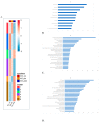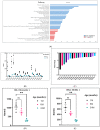Asynchronous Pattern of MAPKs' Activity during Aging of Different Tissues and of Distinct Types of Skeletal Muscle
- PMID: 38338990
- PMCID: PMC10855984
- DOI: 10.3390/ijms25031713
Asynchronous Pattern of MAPKs' Activity during Aging of Different Tissues and of Distinct Types of Skeletal Muscle
Abstract
The MAPK p38α was proposed to be a prominent promoter of skeletal muscle aging. The skeletal muscle tissue is composed of various muscle types, and it is not known if p38α is associated with aging in all of them. It is also not known if p38α is associated with aging of other tissues. JNK and ERK were also proposed to be associated with aging of several tissues. Nevertheless, the pattern of p38α, JNK, and ERK activity during aging was not documented. Here, we documented the levels of phosphorylated/active p38α, Erk1/2, and JNKs in several organs as well as the soleus, tibialis anterior, quadriceps, gastrocnemius, and EDL muscles of 1-, 3-, 6-, 13-, 18-, and 24-month-old mice. We report that in most tissues and skeletal muscles, the MAPKs' activity does not change in the course of aging. In most tissues and muscles, p38α is in fact active at younger ages. The quadriceps and the lungs are exceptions, where p38α is significantly active only in mice 13 months old or older. Curiously, levels of active JNK and ERKs are also elevated in aged lungs and quadriceps. RNA-seq analysis of the quadriceps during aging revealed downregulation of proteins related to the extra-cellular matrix (ECM) and ERK signaling. A panel of mRNAs encoding cell cycle inhibitors and senescence-associated proteins, considered to be aging markers, was not found to be elevated. It seems that the pattern of MAPKs' activation in aging, as well as expression of known 'aging' components, are tissue- and muscle type-specific, supporting a notion that the process of aging is tissue- and even cell-specific.
Keywords: ERK; JNK; MAPKs; p38.
Conflict of interest statement
The authors declare no conflict of interest.
Figures
























References
MeSH terms
LinkOut - more resources
Full Text Sources
Research Materials
Miscellaneous

